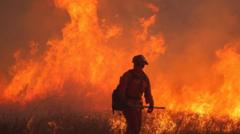The increase is attributed to human activity, particularly greenhouse gas emissions from fossil fuels. However, the specific reasons for last month’s particularly high temperatures remain unclear. Gavin Schmidt, NASA's Goddard Institute for Space Studies director, emphasized that while greenhouse gas concentrations play a significant role in the warming trend, other variables also contribute to the current anomalies.
January 2025’s temperatures were found to be 1.75°C higher than those recorded in the late 19th century. The previous year saw an influence from the El Niño pattern, characterized by warmer tropical Pacific waters, which typically raises global temperatures. In contrast, the onset of La Niña conditions this year was expected to yield cooler temperatures, but the anticipated effect has not materialized.
Adam Scaife from the UK Met Office stated, "If you’d asked me a few months ago, I would have predicted January 2025 to be cooler," revealing the prevailing uncertainty among researchers about current climatic patterns. Theories surrounding the unexplained warmth include prolonged oceanic responses to past El Niño effects and changing ocean heat absorption rates.
Moreover, a notable decline in atmospheric aerosols—which previously masked greenhouse gases by reflecting sunlight—could be contributing to higher temperatures. As these aerosols decrease due to cleaner air initiatives, their cooling effect diminishes, potentially accelerating warming.
Samantha Burgess from Copernicus indicated ongoing observations of ocean temperatures, hinting at a deeper change in ocean behavior that may be affecting the atmosphere. Recent theories suggest that continuing this warming trend could lead to a 'nightmare scenario' involving alteration in cloud formations, further exacerbating the climatic crisis.
Despite the recent upward temperature trend, many experts still predict slightly cooler conditions for 2025 compared to the previous two years, albeit with growing uncertainty. Without significant reductions in greenhouse gas emissions, however, researchers agree that breaking temperature records will likely continue.
Dr. Burgess stated, "In time, 2025 is likely to be one of the cooler years that we experience," highlighting the pressing need for action against emissions to mitigate future warming.
As the world grapples with these climatic challenges, experts emphasize that a thorough understanding of the current temperature anomalies is crucial for predicting future trends and effectively addressing climate change.
January 2025’s temperatures were found to be 1.75°C higher than those recorded in the late 19th century. The previous year saw an influence from the El Niño pattern, characterized by warmer tropical Pacific waters, which typically raises global temperatures. In contrast, the onset of La Niña conditions this year was expected to yield cooler temperatures, but the anticipated effect has not materialized.
Adam Scaife from the UK Met Office stated, "If you’d asked me a few months ago, I would have predicted January 2025 to be cooler," revealing the prevailing uncertainty among researchers about current climatic patterns. Theories surrounding the unexplained warmth include prolonged oceanic responses to past El Niño effects and changing ocean heat absorption rates.
Moreover, a notable decline in atmospheric aerosols—which previously masked greenhouse gases by reflecting sunlight—could be contributing to higher temperatures. As these aerosols decrease due to cleaner air initiatives, their cooling effect diminishes, potentially accelerating warming.
Samantha Burgess from Copernicus indicated ongoing observations of ocean temperatures, hinting at a deeper change in ocean behavior that may be affecting the atmosphere. Recent theories suggest that continuing this warming trend could lead to a 'nightmare scenario' involving alteration in cloud formations, further exacerbating the climatic crisis.
Despite the recent upward temperature trend, many experts still predict slightly cooler conditions for 2025 compared to the previous two years, albeit with growing uncertainty. Without significant reductions in greenhouse gas emissions, however, researchers agree that breaking temperature records will likely continue.
Dr. Burgess stated, "In time, 2025 is likely to be one of the cooler years that we experience," highlighting the pressing need for action against emissions to mitigate future warming.
As the world grapples with these climatic challenges, experts emphasize that a thorough understanding of the current temperature anomalies is crucial for predicting future trends and effectively addressing climate change.





















